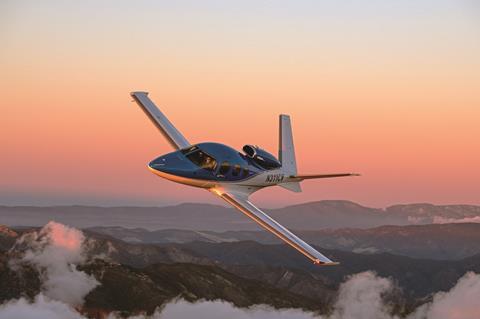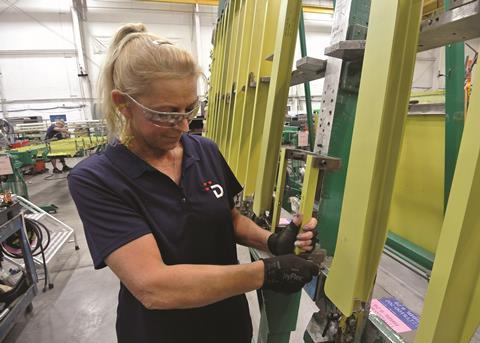We highlight seven companies which stood out in our analysis of the aerospace industry’s largest players.
New arrival: Baykar Technologies
In less than 20 years, Baykar Technologies has emerged as one of the biggest non-US manufacturers of unmanned air systems (UAS), and its influence in the market is set to continue growing. The Istanbul-based company is one of two Turkish companies in the Top 100, along with Turkish Aerospace, and one of seven new entrants to this year’s survey.
Ankara’s defence aerospace sector has been maturing fast, boosted by a government keen to procure as many of its capabilities as possible from local suppliers and enthusiastically encouraging them to pursue export opportunities. Baykar, which was founded as an automotive parts company in 1986 and only began developing UAS in the 2000s, has won customers for its products among several of Turkey’s NATO allies, such as Albania, Poland and Romania, as well as the likes of Azerbaijan, Ethiopia, Kuwait and the Maldives.

The company’s Bayraktar TB2 drones have been used extensively by Ukraine since the start of its full-scale conflict with Russia in 2022, and Baykar will this year open an assembly plant in the country. It has also signed a deal to localise production in Saudi Arabia.
The business may hope that its stance on the war in Gaza – its leaders make very clear their support for the Palestinian cause on Baykar’s website – may give it an edge in certain export contests against Israeli competitors who are also heavyweights in the UAS arena.
Although Baykar is a private enterprise, our colleagues at Counterpoint have used public-domain reports and their knowledge of the sector to estimate the business’s revenues.
Parker Hannifin keeps growing
Parker Hannifin’s £6.3 billion ($7.2 billion) September 2022 merger with UK aerospace supplier Meggitt helped vault the US company four places to 27 with the second highest sales growth in this year’s survey.
It was the latest in a trio of acquisitions over five years to boost Parker’s revenues, following swoops for Lord, which added a range of vibration systems to its aerospace portfolio, and filtration specialist Clarcor.
Meggitt’s product offering, which included braking systems, motion sensors and onboard fire detection and suppression systems, was “highly complementary” to Parker’s flight control and fuel and lubrication systems, said the company.
As part of the UK government’s approval process, Parker agreed to retain Meggitt’s Coventry headquarters, factories, brand, and technical resources in the country. The US business also said the takeover expanded its aftermarket footprint as Meggitt was stronger in that area.
Cirrus Aircraft’s barnstorming performance
A business that began life in a Wisconsin barn in the 1980s and has become the biggest manufacturer of light aircraft in unit terms is included in the Top 100 for the first time.
Duluth, Minnesota-based Cirrus Aircraft – which has been owned by Chinese aerospace giant AVIC since 2011 – produces the SR22, the top-selling piston aircraft for over 20 years, as well as the SF50 Vision Jet, the only single-engined jet on the market.

The company is renowned for its ground-breaking innovation. The SR20 – the SR22’s predecessor that was developed in the 1990s – was the first light aircraft fitted with an emergency parachute. The Collier Trophy-winning SF50 is the only survivor of a swathe of single-engined very-light jet projects launched in the first decade of the century that included the Diamond D-Jet, the Eclipse 400, and the Piper Altaire. It was the first aircraft to be fitted with Garmin Safe Return technology that, with the press of a button, automatically finds the nearest landing strip and lands the aircraft in the case of pilot incapacitation.
Although retail customers remain the company’s biggest demographic, Cirrus has been making inroads into the Part 135 air taxi and corporate flight department segments, as well as expanding its market outside North America, especially in Europe, where there is less of a private flying culture.
In 2021, Cirrus unveiled the latest version of its Vision Jet, the G2+, which comes with Gogo in-flight wi-fi and an improved version of the Williams International FJ33-5A engine.
Triumph over adversity?
The last few years have certainly not been a triumph for one of the supply chain’s biggest brands, which has steadily slid down the Top 100 ranking, dropping from 35th place four years ago to its current 60th position.
Or perhaps they have. Back in 2019, when Triumph was turning over $2.9 billion its margins were a flaccid 2% and it was barely in profit. Last year’s sales of $1.19 billion delivered a much healthier margin of 17.3% (although this was down on a better 2022).
Pennsylvania-based Triumph has slimmed down drastically through closures and divestments – going from 47 operating companies, 14,600 employees, and 73 locations pre-pandemic to five divisions, just over 5,000 employees, and 28 sites in 2023.
It has moved out of certain sectors such as aerostructures and military maintenance completely to focus on component manufacturing in areas including fuel pumps, actuation, interior ducting systems, and gearboxes.
Whether Triumph’s strategy works remains to be seen. At an investors’ day last year, the company set an ambitious target of $2 billion sales and 20% margins, although it did not specify a timescale to achieve that.
General Atomics is flying high
A private company, General Atomics has been traditionally difficult to source accurate financial information from. However, this year we have estimated that the world’s biggest supplier of large unmanned air vehicles is worthy of being included in the survey, its $749 million revenues placing it 78th.
Strictly speaking, its aerospace and defence arm, GA Aeronautical Systems, or GA-ASI, is an “affiliated company” of the larger entity, which is a contractor to the US energy department on its nuclear power programme.

As well as building platforms such as the MQ-9A Reaper and MQ-20 Avenger, GA-ASI designs electro-optical, radar, and surveillance systems. Another offshoot, General Atomics Europe, is developing the NXT variant of the Dornier 228, a business General Atomics acquired from Switzerland’s RUAG in 2021.
General Atomics began as a division of General Dynamics in the 1950s and was acquired by the Blue family in 1986. Neal Blue remains chairman and chief executive of the San Diego-based company.
Daher tops revenue growth chart
French company Daher has moved four places up the rankings, to 55th, with a table-topping almost 69% increase in revenues over the financial year. Robust sales in 2023 of its TBM and Kodiak branded turboprop aircraft helped, but the main factor was its acquisition of a Florida aerostructures factory from Triumph in 2022, along with 400 staff.
The site produces components for Boeing and Gulfstream, but Daher has found itself in a legal dispute with the former owner over alleged breaches of contract during the due diligence process.

Family-owned Daher has been in aerospace since buying the former Socata business in Tarbes, where TBM-series aircraft are built, in 2008, later adding the Kodiak line from Quest in 2019. Before that it was largely a logistics and services company, sectors it is still in, supplying, for instance, contract engineering and skilled production line workers to Airbus.
After delivering 74 aircraft last year, Daher said in February that it was targeting output of “over 80” units in 2024. The company is considering moving some TBM 960 and Kodiak production to Stuart to mitigate capacity constraints at its current final assembly lines, and possible protectionist moves by a new US administration.
Its chief executive has set an aim of becoming a €2 billion ($2.2 billion) business by 2027.
Supporting documents
Click link to download and view these filesTop 100 aerospace companies by revenue 2023
PDF, Size 95.94 kb


























